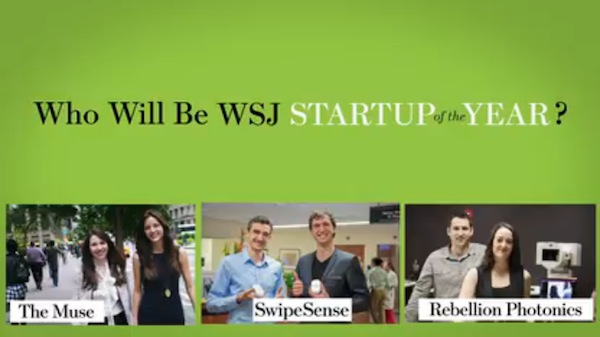
Donald Trump may be a Wall Street Journal reader, but the Journal is not a brand that immediately evokes the style of Trump’s long-running reality show The Apprentice. And yet the Journal is experimenting with its own interpretation of the genre, having just completed a 20-week first-season run of its Startup of the Year online show — a contest that the Journal calls an “interactive crash-course in entrepreneurship.”
Actually, Startup of the Year is more Shark Tank than The Apprentice, says Andy Regal, executive producer of WSJ Video. Regal says he and his colleagues used reality show elements “in the broadest of terms” to fill what they see as a vacuum in coverage of innovation and entrepreneurship.
The series entailed 338 videos, each between about two minutes and seven minutes long, as the Journal tracked 24 new businesses vying for the Startup of the Year title. Last night, it announced the winner is Rebellion Photonics, a Texas-based company that builds chemical imaging cameras that can spot explosive gas leaks on oil rigs.
The 1st WSJ Startup of the Year is Rebellion Photonics! Congrats to the Houston startup! @RebellionPhoton #WSJSOTY pic.twitter.com/O7hgqt0KPr
— Juhi Desai (@JuhiJourno) November 4, 2013
The winner of #WSJSOTY rings the opening bell at the NYSE! pic.twitter.com/NsZda9GbOt
— WSJ Communications (@WSJPR) November 5, 2013
Over the course of 20 weeks, a group of Wall Street Journal editors winnowed down the list of competitors as they completed various tasks and activities — debates, elevator pitches, shooting clay pigeons that represent business frustrations, etc. Contestants were invited to participate in mentoring sessions with billionaire entrepreneurs like designer Tory Burch and Virgin Group founder Richard Branson. Here are some highlights:
The project was a way for the Journal to continue experimenting with video at a time when there’s huge demand for it. (Last year, then-Digital Network managing editor Raju Narisetti told me that “from a business point of view, we cannot generate enough video streams.”)
But Startup of the Year is also a way for the paper to go after an untapped audience of young entrepreneurs and business students. The Wall Street Journal believes it can convert this demographic into a new generation of Journal readers by showcasing a “dramatic slice” of their own world, Regal said.
The Journal’s definition of “dramatic” means exploring the travails of launching a business without the traditional reality-television format of “taking entrepreneurs to bars and showing them in bikinis,” Regal says. So it’s not surprising that much of Startup of the Year feels a bit closer to C-SPAN than E! on the reality TV spectrum. Still, the Journal learned that this kind of storytelling benefits from a lighter approach — combining a “documentary feel with more drama and suspense.”
And although the show traced the path of 24 companies through elimination rounds to a single winner, video producers at the newspaper insist the storytelling approach was meant to be nonlinear.
That’s why, for example, the show’s landing page isn’t organized in a way that lends itself to binge-watching the season in full. Instead, the idea is to encourage viewers to dip in and out of the storyline at any point.
The Journal was reluctant to share specific metrics about Startup of the Year viewership — other than to say content from the series was streamed 1.3 million times — though they’ve already decided to have a second season.
To understand some of the biggest surprises and lessons from season one, I caught up with Regal, deputy managing editor for WSJ Digital Gabriella Stern, and small business news editor Vanessa O’Connell. Here’s what they learned:
We had a voting game where audiences could cast a vote, but people could cast a vote multiple times, so we called it a game. We didn’t take those votes into consideration. We had a couple cafes, some hangouts — we had some in New York, one in San Francisco — where we actually brought together startups, mentors, and members of the broader community to interact. One time we had will.i.am do a surprise mentorship.
We got a little piece of tape [of one of the contestants] sitting on the ground, looking dejected and demoralized next to the wheel of his car and there’s a boot on it. And we got a tape of him saying, “This is really what entrepreneurship is about. Yes, we park illegally. No, we don’t pay the tickets on time. This is what it really takes.” I hope we get a little closer more often to the struggles and the achievements of entrepreneurship.